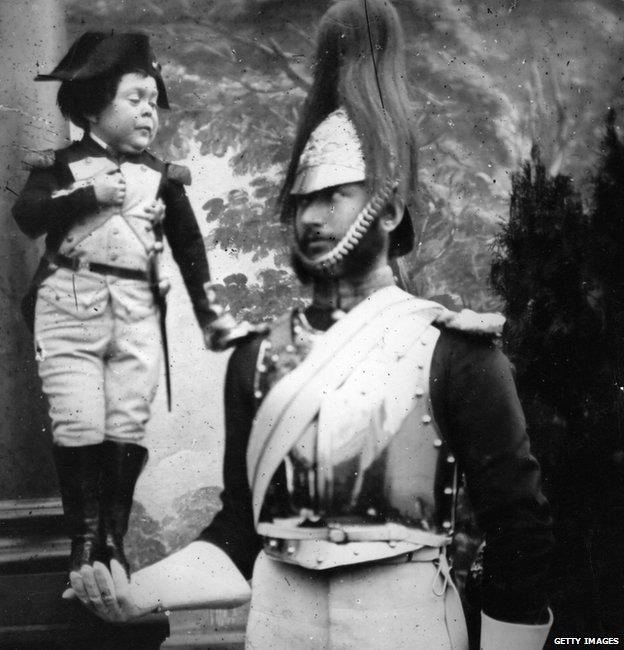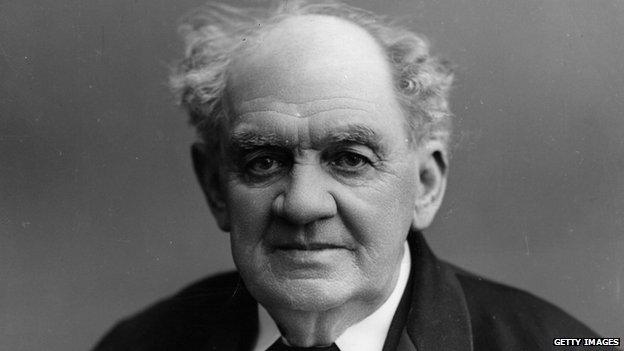The real Tom Thumb and the birth of celebrity
- Published

Charles Stratton, better known by his stage name Tom Thumb, was a dwarf who became a global celebrity in the 19th Century.
When people think of Tom Thumb they may recall the English folklore character, or the children's nursery rhyme, but few, it seems, think of the real life Tom Thumb, a performer who shot to fame in the 1840s, watched by 50 million people worldwide, and a firm favourite with both Queen Victoria and Abraham Lincoln.
In the winter of 1842, legendary showman PT Barnum was stranded in Stratton's hometown of Bridgeport, Connecticut. His New York based "freak shows" were becoming very popular and it seems he was keen to meet a four-year-old "extraordinary local boy" he had heard the townsfolk talk about, said to be just 25 inches tall.
"The public at the time craved freaks of nature," says Lord Grade who presents a new documentary on the life of Tom Thumb. From people covered in hair and dubbed cannibals, to giants and dwarves, Barnum offered people the chance to see them in his Hall of Living Curiosities.
No questions were asked about the appropriateness of this type of show at the time. "You have to remember that 'freaks' were big business then, and there were quick bucks to be made," Grade says. Speaking from his experience of TV production he says that decisions have to be made now about whether a person is fully consenting.
At the time though, it was an attractive gig for many, who with their "weirdly shaped" bodies were often ostracised and impoverished due to a lack of work. Stratton's parents saw this as an opportunity and consented as soon as Barnum offered a hefty $3 per week (about £70 a week) to their son. The four-year-old was put on a month's trial at Barnum's notorious American Museum in New York and had pride of place in the line-up.
Barnum had big plans for Stratton. He kitted him out in custom made suits and boots, came up with witty skits, said he was from England and told audiences the boy was a much older 11 to avoid accusations he was merely exhibiting a slightly smaller than average child. Most importantly though, Barnum changed the boy's name to General Tom Thumb, after the English folklore character. It was brilliant branding and the press took the bait, says Professor Eric D. Lehman, author of Becoming Tom Thumb. "The title General is a classic celebrity status enhancement such as Prince, Madonna, Count Basey."
The media, like Barnum, were not concerned with issues of exploitation. "General Tom Thumb Jr., the dwarf, is the most wonderful specimen of a man who ever astonished the world," one newspaper wrote. "The idea of a young gentleman, 11-years-old weighing less than an infant of six months is truly wonderful."
Next on Barnum's list was to ensure Stratton became an international star, and London was the place to go. It was a brave move as the two countries had been at war just 30 years earlier, and many in England's capital prided themselves on being more respectful and dignified than the Americans. There was a worry that Londoners would find a performing dwarf simply crass.

General Tom Thumb quickly became a worldwide success and was popular with women
The initial reception was poor, but ever the publicist Barnum managed to turn their fortunes around and quickly learnt the importance of class status in England and the marketing of Stratton to the upper echelons. Aristocratic endorsement quickly advanced his popularity. Knight led to lord and lord led to duke until they got a personal invitation from Queen Victoria to Buckingham Palace.
"Good evening ladies and gentlemen," was a six-year-old Stratton's introduction to the royal court. It wasn't exactly the protocol Queen Victoria was used to. With his entertainer's hat on Tom Thumb launched into a routine singing cheeky songs and rattling off impressions. The court were officially in mourning for Prince Albert's father so it was a risky tactic.
But nobody kicked them out. And, when it came to leaving, Barnum was well briefed in the etiquette of not turning your back on the monarchy and knew to walk backwards. Stratton tried to keep in step but his little legs wouldn't let him so he would turn and run and stop and turn around to bow again and again. It set off a royal spaniel, the same height as the boy, who barked incessantly. Stratton, ever the performer got out his tiny ceremonial sword and pretended to fight the dog. The court erupted, Queen Victoria was amused and they were invited back to the Palace.
Stratton's fame was secured and for the next three years he toured Europe with Barnum. Wherever he went he was mobbed by hysterical crowds. Women queued around the street to get a kiss from him and there are reports of husbands "driven wild with jealousy", Lord Grade says.
The next logical step for Barnum was a celebrity wedding. In February 1863, he arranged for Charles to marry one of his other turns, Lavinia Warren, also a person of restricted growth. Their wedding was eagerly anticipated and it featured on the front page of the New York Times on the days leading up to the event - even though it was at the height of the civil war. Harpers magazine snapped up the wedding photographs for its cover which were taken in advance, and President Abraham Lincoln hosted their honeymoon party.

Stratton married Lavinia Warren and they both insisted their marriage was real
But, as with celebrity weddings of today, some believed it was a cynical publicity stunt. Stratton was quick to react to this. He said: "It is true we are little but we are as God made us, perfect in our littleness," he wrote. "We are simply man and woman of like passions and infirmities with you and other mortals. The arrangements for our marriage are controlled by no showman'."
The wedding boom indeed made the enterprise more successful. The next plan to increase their fame further would be the addition of a child, and Barnum was, as ever, happy to fix this. He rented babies from foundling hospitals for photo shoots and personal appearances, and the crowds went crazy. When that idea had run its course, Barnum simply said the child had died.
Here, Lord Grade says that Barnum had overstepped the mark and moved from entertainer to exploiter.
Lavinia confessed to the baby hoax in her autobiography and her version of events has gone unquestioned for years. However, in an unusual twist, historian John Gannon has discovered that this may not have been the case and revealed paper evidence in the documentary that seems to prove the child was in fact Charles and Lavinia's after all.

Other PT Barnum acts

Fiji mermaid: The body of an orangutan and the base of a fish that people believed was a genuine specimen
Chang and Eng Bunker: Thai-American conjoined twin brothers whose condition and birthplace became the basis for the term "Siamese twins"
Josephine Clofullia: A Swiss-born bearded lady

Stratton could easily have retired as a young child, he had earned a large amount of money that paid for his sisters to go through private education, but he went on touring for many years. He clearly enjoyed the stage, and though others questioned whether Barnum was exploiting him, Stratton proved himself to be entirely in control of his own show later in his career.
Mat Fraser, a modern day actor who is thalidomide-impaired, and who performs a freak show skit, thinks there are clear reasons why Stratton was continually drawn to the stage.
"Here's the thing that non-disabled people tend to forget: you do your show and a thousand people think you're fantastic, you walk out the stage door and some fella's staring at you on the street again," he says. "BANG! You're back there, you're always back there. Of course you want to be back on the stage, it's a delicious power that I wouldn't know what to do without."
Eventually the Strattons settled down in Warren's home town of Massachusetts where they built a mansion complete with custom made small furniture. He died suddenly at the age of 45 and more than 10,000 people travelled to see his body lying in state. Eight years later Barnum was buried just a few feet away.
Follow @BBCOuch, external on Twitter and on Facebook, external, and listen to our monthly talk show